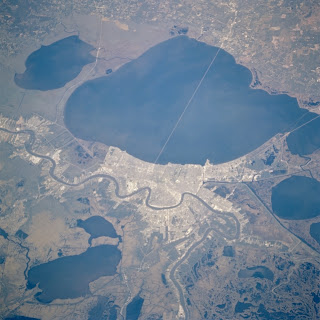Surrounded by three bodies of water; the Mississippi River,
Lake Borgne, and Lake Pontchartrain, New Orleans at its highest point sits at a measly 25 feet above sea level.
 |
| New Orleans, virtually surrounded by water. (http://www.weather-forecast.com/weatherobjects/map/N/New-Orleans.jpg) |
The Mississippi River is responsible for most of New Orleans’
landforms. New Orleans soil is
made up of silt, which comes from run-off from the Mississippi river, which
over the years has piled up. This
rich soft soil is constantly covered with water every time the river floods or
a storm comes in from the ocean, creating New Orleans unique wetland landscape
of swamps, salt-water marshes, and bayous. The wetlands are brimming with life and help protect the
land from the storms and hurricanes that constantly threaten the longevity of
New Orleans.
New Orleans geographical location is relatively close to the
equator. Warm weather and intense
humidity, which come with such a location, have created New Orleans’ Humid
Sub-Tropical Climate.
New Orleans Landscape is constantly changing. The delicate silt that makes up the
soil is easily eroded, and flooding from all sides in an especially storm-prone
area of the United States makes New Orleans especially susceptible to erosion
and weathering. New Orleans exists
at the bottom of one of the countries largest drainage systems and is
vulnerable to flooding at all sides.
Something as simple as snow melting in Minnesota can be responsible for
catastrophic flooding in New Orleans.
 |
| Path of the Mississippi River (http://maps.bpl.org/id/10988) |
The Next 100 Years.
Due to the make up of New Orleans soil, the flooding of its
land, and a poorly constructed levee system, New Orleans is destined to be the
victim of disaster in the next 100 years.
The majority of New Orleans is already below sea level, and information
gathered by Canada’s RADARSAT satellites have shown that parts of the city are
currently sinking at a rate of an inch per year, while on average New Orleans
is sinking at a rate of a quarter of an inch every year.
 |
| New Orleans is sinking at an increasing rate (http://earthobservatory.nasa.gov/IOTD/view.php?id=6623) |
While this is already a drastic rate, by
taking Global Climate Change into account, one can only assume that this rate
is destined to increase. With ice
melting into the ocean, sea levels rising, and weather getting more and more
polarized, the next 100 years holds not only more but deadlier storms, while
New Orleans elevation plummets.
New Orleans’ watery landscape is also a hot bed for disease. It is more likely than not that New
Orleans’ population will fall victim to waterborne disease in the next
century. Hurricanes cause not only
flooding but fatalities to both humans and wildlife (Hurricane Isaac killed a
decent amount of Louisiana’s deer population). When you combine decomposing
corpses with stagnant water (common from flooding) you get a deadly
combination. Mosquitoes breed in
water and carry disease, dead animals often host diseases, and floods lead to
unsanitary living conditions. This
evidence and past history (New Orleans lost over 40,000 of its population to
yellow fever in the 1800s) clearly shows that New Orleans will probably be the
breeding ground of some disease, if not multiple diseases in this century.
 |
| One of Hurricane Isaac's many victims. (http://www.nola.com/hurricane/index.ssf/2012/11/hurricane_isaac_disease_a_one-.html) |
Next 1,000+ Years
Unfortunately, it is improbable that New Orleans will be
around in 1,000 years (let alone 10,000 or 1,000,000 years). When you look at the increasingly high
rate at which New Orleans is sinking along side any information on global
climate change, there is really only one conclusion you can reach; which is
that New Orleans will not be around for much longer. It is estimated that New Orleans will be completely
underwater by the year 2400 (with cities like Los Angeles have even less time). What
we as citizens of planet earth need to do is prevent the sea level from climbing
more than it naturally would. We
need to slow down global climate change before more of the land we live on
falls into the sea.










